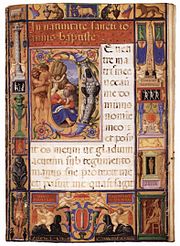Giulio Clovio: Difference between revisions
→External links: Added external links |
Name correction |
||
| Line 1: | Line 1: | ||
{{NPOV}} |
{{NPOV}} |
||
[[Image:Julije Klovic 2.jpg|right|thumb|280px|Portrait of Juraj Julije Klovic, [[El Greco]]]] |
[[Image:Julije Klovic 2.jpg|right|thumb|280px|Portrait of Juraj Julije Klovic, [[El Greco]]]] |
||
'''Giorgio Giulio Clovio''' ([[1498]]–[[1578]]), called only in Croatia as ''Juraj Julije Klović'' ,Italian illuminator, miniaturist, and painter, also called Macedo or Il Macedone because of his Macedonian origin and by profession a priest. |
|||
Klović was born in [[Grizane|Grižane]], [[Croatia]] (some local people said that his birth place was [[Drivenik]]), near [[Crikvenica]] in [[Kvarner bay]]. He was said to have learned the elements of design in [[Dalmatia]], and to have studied afterwards with intense diligence at Rome under [[Giulio Romano]], and at [[Verosia]] under [[Girolamo dai Libri]]. He excelled in historical pieces and portraits, painting as for microscopical examination, and yet contriving to handle his subjects with great force and precision. |
Klović was born in [[Grizane|Grižane]], [[Croatia]] (some local people said that his birth place was [[Drivenik]]), near [[Crikvenica]] in [[Kvarner bay]]. He was said to have learned the elements of design in [[Dalmatia]], and to have studied afterwards with intense diligence at Rome under [[Giulio Romano]], and at [[Verosia]] under [[Girolamo dai Libri]]. He excelled in historical pieces and portraits, painting as for microscopical examination, and yet contriving to handle his subjects with great force and precision. |
||
Revision as of 23:36, 17 December 2006
The neutrality of this article is disputed. |

Giorgio Giulio Clovio (1498–1578), called only in Croatia as Juraj Julije Klović ,Italian illuminator, miniaturist, and painter, also called Macedo or Il Macedone because of his Macedonian origin and by profession a priest.
Klović was born in Grižane, Croatia (some local people said that his birth place was Drivenik), near Crikvenica in Kvarner bay. He was said to have learned the elements of design in Dalmatia, and to have studied afterwards with intense diligence at Rome under Giulio Romano, and at Verosia under Girolamo dai Libri. He excelled in historical pieces and portraits, painting as for microscopical examination, and yet contriving to handle his subjects with great force and precision.

He worked in Venice, Florence and elsewhere, with a long active period in Rome where he died. His grave is in the Church of San Pietro in Vincola, the same church that keeps celebrated Michelangelo's Moses. Under Klović's bust, beside his name, is written the name of his homeland,[citation needed] which he always emphasized: Julio Clovio de Croatia. He was also called Macedo, or Macedone, to connect him with his supposed Macedonian ancestry.
The renowned Giorgio Vasari, the first art critic of the modern world, considered Klović to be the greatest miniaturist of the time and included him within his famed artists' biographies (second edition, 1568).
El Greco, a celebrated Greek artist from Spain, who painted with crepuscular and mystical atmospheres, painted a portrait of Klović and enlisted him as one of the four painters whom he himself considered as his teachers—side by side with Michelangelo, Tizian and Raphael. Juraj Julije Klović was also known as Michelangelo of the miniature. Codexes with his miniatures became famous primarily due to his skilled illustrations. He was curiously persuasive in transferring the entire multilayered look that was present in the famous pictures of the Italian high Renaissance into the miniature format.
His book of twenty-six pictures representing the procession of Corpus Domini, in Rome, was the work of nine years, and the covers were executed by Benvenuto Cellini. The British Museum has his twelve miniatures of the victories of the Emperor Charles V. In the Vatican library is preserved a manuscript life of Frederick, duke of Urbino, superbly illustrated by Clovio, who is facile princeps among Italian miniaturists.
Other illustrations by him are kept in libraries in Vienna, New York, Munich, and Paris, and other figures are parts of many private collections. A small part of his work is viewable in Klovićevi Dvori ("Palace of Klović"), the art gallery dedicated to him in Zagreb.
